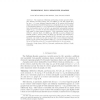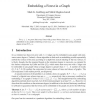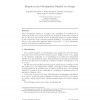102
click to vote
SIAMDM
2010
14 years 7 months ago
2010
Bounds on the minimum degree and on the number of vertices attaining it have been much studied for finite edge-/vertex-minimally kconnected/k-edge-connected graphs. We give an ove...
103
Voted
JGT
2010
14 years 7 months ago
2010
Thomassen [9] conjectured that for all natural numbers k > 0 and m, every graph of minimum degree k + 1 contains a cycle of length congruent to 2m modulo k. We prove that this ...
102
Voted
CORR
2010
Springer
14 years 7 months ago
2010
Springer
For p 1, we prove that every forest with p trees whose sizes are a1, . . . , ap can be embedded in any graph containing at least p i=1(ai + 1) vertices and having minimum degree ...
99
Voted
APPML
2011
14 years 7 months ago
2011
The k-domination number of a graph is the cardinality of a smallest set of vertices such that every vertex not in the set is adjacent to at least k vertices of the set. We prove t...
130
Voted
COMBINATORICA
2010
14 years 10 months ago
2010
In this paper, we propose a simple and natural randomized algorithm to embed a tree T in a given graph G. The algorithm can be viewed as a "self-avoiding tree-indexed random ...
116
click to vote
SIAMDM
2010
14 years 10 months ago
2010
Let s < t be two fixed positive integers. We study what are the minimum degree conditions for a bipartite graph G, with both color classes of size n = k(s + t), which ensure t...
104
click to vote
JGT
2010
14 years 11 months ago
2010
In 1996, Ota and Tokuda showed that a star-free graph with sufficiently high minimum degree admits a 2-factor. More recently it was shown that the minimum degree condition can be ...
JGT
2010
14 years 11 months ago
2010
An edge-colored graph G is rainbow edge-connected if any two vertices are connected by a path whose edges have distinct colors. The rainbow connection of a connected graph G, deno...
COMBINATORICS
1999
15 years 3 days ago
1999
It is proven that for every fixed h, a and b, a graph with n vertices and minimum degree at least h-1 h n, which contains no copy of Kb (the complete graph with b vertices), conta...



